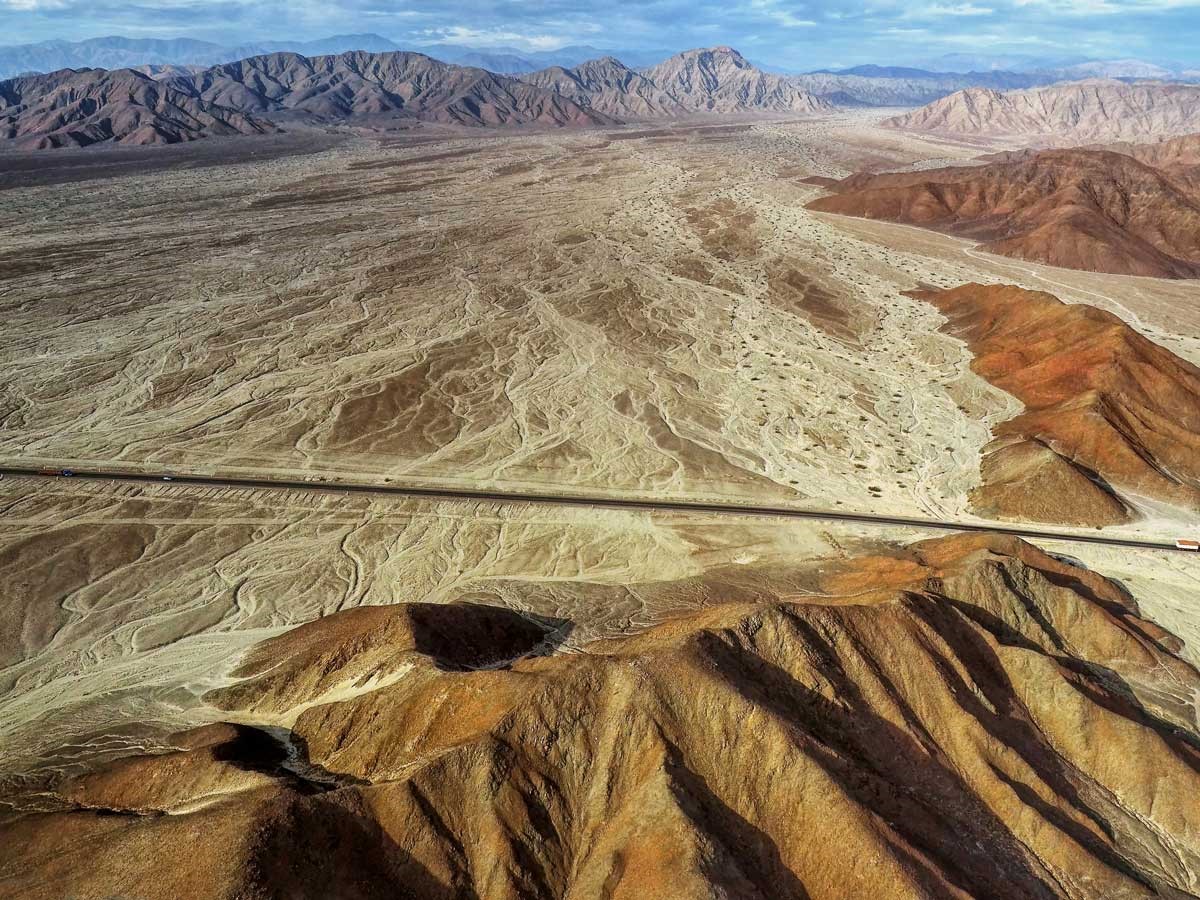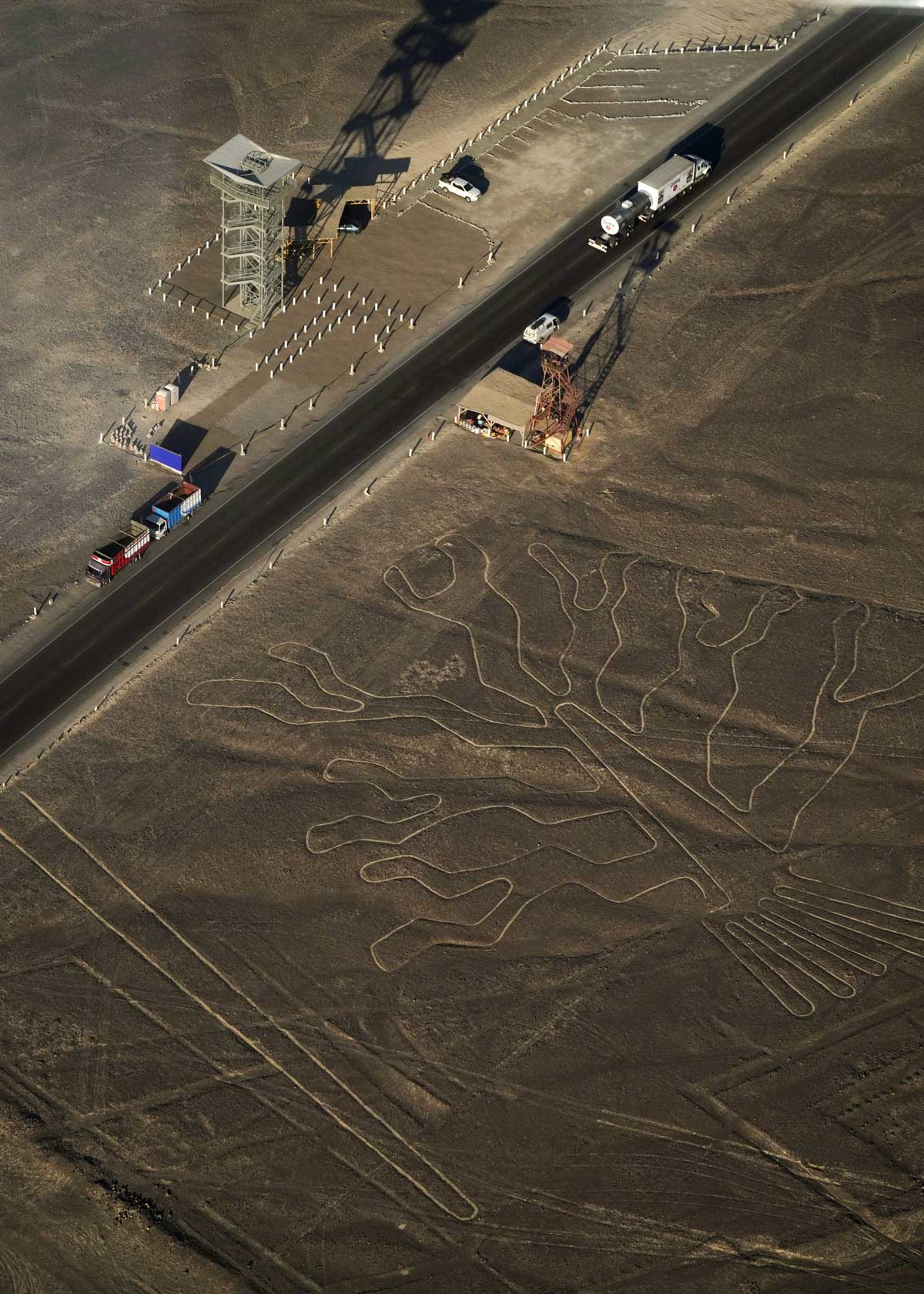Your booking cart is empty!
One of the most intriguing explanations for the appearance of the geoglyphs is the idea of the Peruvian desert as an ancient spaceport. According to this theory, the giant lines were created for communication with extraterrestrial civilizations or used for observing celestial bodies. This hypothesis is supported by their strange shapes, which stretch for tens of kilometres, creating images of animals and geometric figures visible only from a high altitude.
The history of the discovery of the drawings on the Nazca Plateau in Peru
The history of the discovery of the lines in the Peruvian desert, covering an area of more than 50 kilometers, begins in 1927, when archaeologist Toribio Mejia Xesspe decided to study this little-known region. During his research, he discovered enormous geometric figures carved into the desert landscape. Their good preservation was ensured by the dry climate and the low population density of this area.
The majority of the geoglyphs were discovered relatively recently. Thanks to airplane flights and aerial photography, which allowed for the observation of the enormous drawings, some of which reach hundreds of meters in length, a unique "catalog" of drawings was compiled. This catalog includes about 143 images (such as birds, flowers, monkeys, and spiders) and tens of thousands of various lines and stripes.

Over time, these drawings have raised more and more questions and sparked increasing curiosity among scientists and archaeologists from around the world.
One of the most mysterious features of the lines is their enormous size and precise execution. Some of them are over 200 meters long, and their lines are so straight and even that it seems as if they were created by special tools rather than human hands.
Theories of the origin of these geoglyphs
There are several theories regarding the origin of these geoglyphs in South America. Some scientists believe they are a kind of astronomical calendars or even spaceports for extraterrestrial visitors. Others lean towards the idea that they are simply natural phenomena resulting from the effects of wind and rain on the sandy surface. The second half of the 20th century became a period of active exploration of these drawings.
The mysteries and secrets of the Nazca Plateau: ancient spaceport or natural phenomena?

These enormous drawings on the ground are truly astonishing: they form various geometric shapes resembling animals and plants, and their sizes reach several hundred meters. But the question of what these stone lines represent and how they were created remains open to this day. One theory links the figures to a spaceport for ancient astronauts. According to this version, the lines were used to mark locations for the takeoff and landing of spacecraft. Their gigantic sizes were symbolic, intended for navigation on Earth and correlation with planets or stars.
However, there is an opposing viewpoint, according to which the geoglyphs are simply natural phenomena. Normally invisible, these forces shape lines and depressions through the action of wind, water, or other natural factors. Despite ongoing research into these mysterious symbols, there are no concrete pieces of evidence confirming one of these theories or, conversely, refuting them, except for common sense.
The architecture and geometry of the Nazca lines: evidence of ancient technologies or randomness?

The architecture and geometry of these lines never fail to evoke wonder, as well as a host of questions about how such complex and precise forms were created. They are enormous figures depicted on desert plains, visible only from the air.
There are speculations that the creation of such intricate geometric shapes was achieved using ancient technologies. Many researchers believe that various tools and measurement methods were employed for construction and delineation. This suggests a high level of mathematical and engineering knowledge among the creators of the drawings. However, scientists argue that the dates of the drawings' creation coincide with times when local cultures and peoples had little to no knowledge of glass or metal, let alone possession of any unique technologies. This further fuels the interest of esoteric enthusiasts. After all, it implies that such advanced technologies could have arisen spontaneously, rather than through the progressive evolutionary development of local traditions and cultures.

Indeed, in the myths of the local Peruvians, there are mentions of six fair-faced gods who descended to the people directly from the sky. They shared knowledge with the local indigenous people about agriculture, construction, medicine, astronomy, and mathematics. This, in turn, led to an explosive growth in the development of most South American peoples. Grandiose cities began to be built, including those in the highlands. Religion and distinct cults emerged, astronomical calendars were created, and life expectancy increased.
Research and hypotheses: what do scientists say about the origin of the Nazca geoglyphs?
The existence of the unusual lines in the Peruvian desert remains a mystery for researchers. Scientists have proposed several hypotheses attempting to explain the origin of these impressive figures.
One hypothesis suggests that the lines are an expression of ancient religious beliefs and rituals, possibly by the ancient Peruvian Paracas culture (750-100 BCE). They may have been used for conducting rituals related to the cult of the sun and rain, which were important for the desert inhabitants of the Nazca, Ica, and Paracas regions.
Interestingly, quite recently in 2018, researchers discovered over 30,000 identical pits in the desert, which together formed a mathematically aligned line stretching from the Nazca Plateau to the Andean foothills. Scientists speculated that the depressions were intended for water collection or as storage for cultivated crops, but no evidence has been found to support these hypotheses.
There is also the opinion that the geoglyphs could be the result of natural phenomena such as wind erosion and geological processes – they are a random natural occurrence resulting from natural erosion and other geological processes. This hypothesis explains the complexity of creating such enormous figures and their resemblance to natural forms.
In any case, the geoglyphs are a unique Peruvian heritage that requires special care and maximum preservation. Over the past decades, the geoglyphs have been subjected to various threats, such as human interference, uncontrolled tourism, and changes in natural conditions. In 1994, the Nazca geoglyphs were inscribed on the UNESCO World Heritage List. However, they undoubtedly continue to be a source of hypotheses and ideas, stirring the minds of both scientists and enthusiasts of the unknown and unexplained.